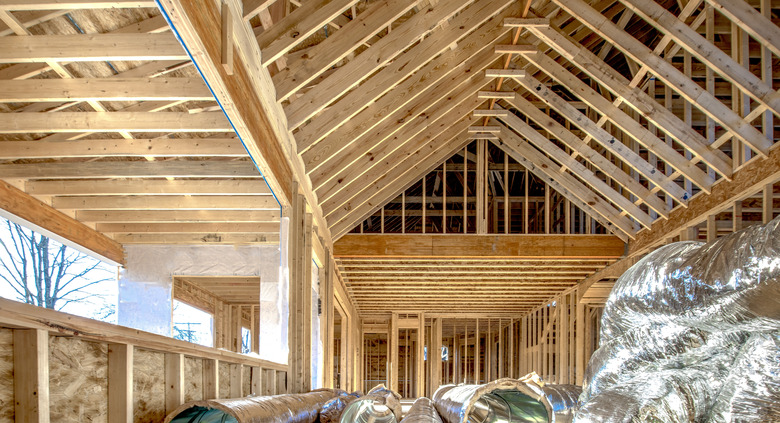What Size Nails Do You Use For Framing?
Framing is part of the rough construction phase of building, and it mainly involves fastening 2-by (1 1/2-inch-thick) lumber. You construct walls by fastening two-by-fours together, and when building floors and roofs, you're usually joining two-by-sixes and even two-by-eights to each other. The nails have to be strong to resist shear forces, so builders usually use common nails as opposed to box nails because commons are thicker. Common nails come in various lengths, and three of those lengths are especially important for framers. If you use a nail gun instead of a hammer, you'll need framing nails for the nail gun. Most guns shoot only one particular type of nail, so you have to choose the gun according to the task at hand.
The Penny System
The Penny System
When you buy nails in bulk in the United States, you'll be using a designation system that dates back to 15th-century England. Instead of identifying nails by length, retailers often identify them by the penny system, and as if that's not archaic enough, the symbol for penny is "d," which refers to the Roman penny, the denarius. American builders are among the few in the world who still measure in feet and inches, though, so they are no strangers to anachronism.
A 16-penny nail, designated 16d, is always 3 ½ inches long, whereas a 10d nail is 3 inches long, and an 8d nail is 2 ½ inches long. These length correlations apply only to common nails; box nails are a little shorter. Those three lengths are the ones most commonly used in framing.
Galvanized and Vinyl Sinkers
Galvanized and Vinyl Sinkers
A framer fastening two-by-fours together to build a wall typically uses a 16-penny nail to fasten the studs to the top and bottom plates. Sometimes studs have to be doubled to make door trimmers or headers. 10d nails are better than 16d nails for this because they won't penetrate all the way through the joined boards. When toenailing, which means to drive nails at an angle to secure a butt joint, 8d nails are best. Interior framing nails have a vinyl coating to make them easier to drive. They are known as vinyl sinkers. When doing exterior framing, framers use galvanized nails, which are rust resistant.
Framers have occasion to use nails of other sizes. When securing joist hangers, they use special 2d common galvanized nails, which are 1 inch in length. When securing plywood sheathing, they typically use 6d, or 2-inch, common nails.
Choosing the Right Framing Nails for a Nail Gun
Choosing the Right Framing Nails for a Nail Gun
The nails that fit in a particular nail gun are typically bonded together in rows to fit into the gun's magazine, and they are usually identified by nail length. If you buy your framing nails at Home Depot, Lowe's or any other store, be sure they are recommended for the gun you're using. Bostich framing nails, for example, are designed for a Bostich nail gun and may not work with your Makita or Porter Cable tool.
The magazine on some nail guns has a steep angle relative to the tip, which allows the gun to be used in tight spaces. To fit into these magazines, the nails may have clipped heads. Check your local codes before using these because they might not be allowed for certain structural and framing applications in your community.
